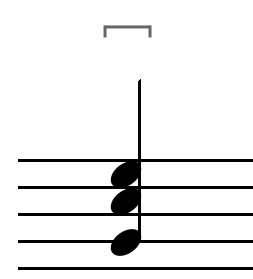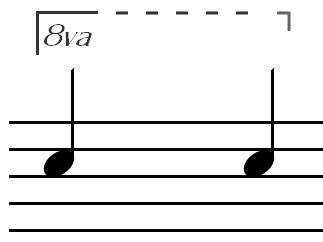Groups Within a Measure
There are several groups that are not called from the library with an #id, although parts within them do. This page explains why, and how to use them. They are:
Extention Line
In guitar music, a Roman numeral is typically used to indicate a barred cord. When it is held for a time, a line following it shows for how long. I use a dashed line. Unlike a solid line, when you scale a dashed line the dashes and spaces stretch (or shrink). In addition, there is a separate end marker, so you use a group, and set position and length were needed in the sheet music without referencing the library.

<use x="24" y="0" xlink:href="#V"/>
<g transform="translate(24,0)"><!-- dashed line; same coordinates as top note -->
<line x1="42" y1="-150" x2="180" y2="-150"
style="stroke:#665; stroke-dasharray:12,18; stroke-width:3"/>
<use x="180" y="-150" xlink:href="#exlnd"/>
</g>
<use x="24" y="0" xlink:href="#hanu"/><use x="24" y="36" xlink:href="#hanu"/>
<use x="24" y="60" xlink:href="#hand"/><use x="24" y="108" xlink:href="#hand"/>
Occasionally, you may want to use the line without the end marker; no need for a 'group'; place and length as needed, but remember; you're now in the measures coordinate grid, not an internal group.
Pinky Bar
What I call a pinky bar is a short bar using a finger other than the index. Barring the first two strings with the little finger comes up fairly often; hence the name. As with the extension line, you set position and length were needed.

<g transform="translate(24,12)"><!-- at top note coords -->
<line x1="-21" y1="-132" x2="24" y2="-132" style="stroke:#665; stroke-width:3"/>
<use x="-21" y="-132" xlink:href="#pbnd"/><use x="24" y="-132" xlink:href="#pbnd"/>
</g>
<use x="24" y="12" xlink:href="#note"/><use x="24" y="36" xlink:href="#note"/>
<use x="24" y="72" xlink:href="#solnu.5"/>
Triplet Symbol
The arch of the triplet symbol is treated the same as a slur. The three needs to be adjusted as the arch is rotated and scaled.

<g transform="translate(32,-30)">
<use xlink:href="#triarc" transform="scale(.96,1)"/>
<text class="instruct" x="57" y="-33">3</text>
</g>
<use x="18" y="60" xlink:href="#solnu"/>
<use xlink:href="#be" transform="translate(32,-25) scale(.96,1)"/>
<use x="66" y="48" xlink:href="#solnu-1"/><use x="114" y="60" xlink:href="#solnu"/>
First & Second Ending
Like the former symbols with lines, first and second ending brackets are in a group to extend the line to whatever length you need (while holding all the parts together). Unlike a dashed line, the second line in this group can be extended by scaling x, if you choose.

<g transform="translate(0,0)"><!-- first ending; note coords here -->
<line x1="-42" y1="42" x2="-42" y2="-1.5" transform="translate(0,-150)"
style="stroke:#333;stroke-width:3;shape-rendering:crispEdges"/>
<line x1="-42" y1="0" x2="200" y2="0" transform="translate(0,-150)"
style="stroke:#333;stroke-width:3;shape-rendering:crispEdges"/><!-- second line extended where needed -->
<text class="repno" x="-33" y="-117">1.</text>
</g>
Octava
Use of the octava is no different than other symbols with lines.

<g transform="translate(50,36)"><!-- octava; note coords here -->
<polyline points="-21,42 -21,0 39,0" transform="translate(0,-150)"
style="fill:none;stroke:#333;stroke-width:3;shape-rendering:crispEdges"/>
<text class="repno" x="-18" y="-117">8va</text>
<line x1="57" y1="-150" x2="200" y2="-150"
style="stroke:#333;stroke-dasharray:12,18;stroke-width:3"/>
<use x="200" y="-150" xlink:href="#exlnd"/>
</g>
Next ⇒ ⇐ Previous